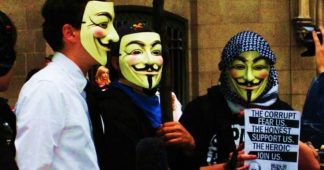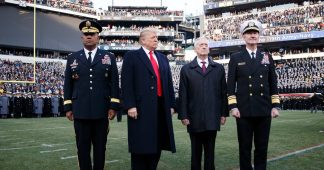A new Showtime docuseries reminds us of just how awful Ronald Reagan was and how his brand of demagogic racism became a model for Trump.
By Eileen Jones
Dec. 12, 2020
Watching the four-part Showtime docuseries, The Reagans, is an interesting form of leftist self-punishment for all you masochists out there. You may be familiar with most of the Ron and Nancy horror show laid out here in traditional documentary form through lavish photos, clips, and talking-head interviews.
Memories, how they linger — from calling in the National Guard on peaceful student protesters in Berkeley as governor to breaking the Air Traffic Controllers’ strike as president, to forcing disastrous tax cuts, massive military escalation, corporate deregulation, and “trickle-down economics” upon us. There’s even the story about how Reagan got the idea for the delusional and costly “Star Wars” missile defense system from a ray gun he carried in one of his old B movies — it’s all here!
But some of the details that you probably forgot — or maybe never knew — will make you groan aloud in pain that this man was unleashed upon the country at such a pivotal moment. And that his legacy, sadly, is seen everywhere today.
You doubtlessly recall Reagan’s notorious attempt to undermine support for the welfare program while president — the fantasy of black “welfare queens” rolling up in Cadillacs to collect their checks. But have you ever heard Reagan’s racist talk about life in California in the 1960s, such as the city streets that become “jungle paths after dark”? That’s the kind of racist dog whistle Reagan first used to get himself elected governor of California in 1966, defeating beloved two-term progressive Democratic governor Pat Brown.
The material covered in the second hour-long episode of the series, titled “The Right Turn,” is the most important in the series, according to director Matt Tyrnauer in a recent interview with Jacobin. It covers Reagan’s early political career, backed by a powerful consortium of California millionaires who raised the money for his gubernatorial campaign “over lunch,” after Reagan’s turn from a New Deal Democrat to a rigidly conservative Goldwater Republican made him their perfect candidate. This early era of Reagan’s political career is less well known to mainstream America. Thankfully, the docuseries is helping to change that, exposing Reagan’s aggressive use of “institutional racism” to win over white voters frightened of civil rights gains and the newly proposed fair housing laws.
Tyrnauer says that if he’d had to make only a one-hour documentary on the Reagans, instead of the four-hour series commissioned by Showtime, he’d choose this episode for the way it draws a straight line between Ronald Reagan and Donald Trump for those who would deny the connection:
“How is it possible that even never-Trump Republicans can still say Ronald Reagan is their hero? He practiced the same kind of demagogic racism [as Trump]!”
The refusal to recognize the similarities between Trump and Reagan is characteristic of centrist Democrats as well, who consistently represent Trump as a horrifying anomaly instead of a fairly standard Republican when it comes to policy. As a result of the attitude that Trump is a monster the like of which we’ve never seen before, there’s been a bizarre whitewashing of George W. Bush’s heinous reputation. Now, pre-Trump Republican presidents are suddenly regarded as fine, statesmanlike, “decent men” by comparison.
“I like to quote Gore Vidal, who said ‘We live in the United States of Amnesia,’” as Tyrnauer puts it.
To Tyrnauer’s chagrin, some American film reviewers are failing to connect those dots between Reagan and Trump, however strongly they’re emphasized in the docuseries. The obvious indicators include Reagan’s 1980 presidential campaign motto, “Let’s Make American Great Again,” which made an abbreviated reappearance on millions of pro-Trump MAGA hats.
Like Trump, Reagan’s landslide victory in 1980 came as a shock to most liberals. His entire career, as Tyrnauer puts it, seemed to “rise invisibly through the 1960s.” Just as liberals mocked Reagan for being a “middling washed-up ex-actor” in 1980, Trump, too, was dismissed at first as nothing more than a vulgar TV star. The same Dr Anthony Fauci who tried and failed to reason with Trump about the urgency of the COVID-19 epidemic once tried and failed, as a much younger man, to reason with Reagan about the urgency of the AIDS epidemic.
It’s ironic, Tyrnauer says, that the primary complaint about the docuseries is that when it comes to the Reagans, we’ve simply seen it all before: “Because you haven’t.”
In fact, much of the footage in The Reagans has been seen rarely or never. In the crucial second episode, for example, we see Nancy Reagan being interviewed in her new post as First Lady of California. She relentlessly complains on camera about the supposedly unlivable governor’s mansion — complaints she would repeat when she got to the White House and began angling for expensive remodeling of the private rooms. That documentary video was only shown once, and was sufficiently unflattering that Nancy Reagan asked to have it destroyed.
Tyrnauer begins and ends the series with Reagan’s claim, “If you’re not a good actor, you can’t be a good president.” At the start, from behind the scenes, we’re shown Reagan delivering a presidential speech for the cameras, holding a dignified pose and never fluffing a line. This kind of image construction seems very familiar by now, but for Tyrnauer it’s still an urgent issue, because of a tendency in the general public to watch political performances uncritically. “People need to be grabbed by the lapels and shaken: ‘You’re not looking at reality!’”
And indeed, Reagan was notoriously as far from reality as he could get. There was so much filmed evidence of Reagan’s confusion with fantasy role play versus reality that Tyrnauer had to pick and choose among countless examples. As the late Michael Rogin laid out in pitiless detail in Ronald Reagan, the Movie, Reagan consistently confused his reel life with his real life in a way that dangerously determined presidential policy.
It was a syndrome that began early in life, as the docuseries demonstrates, and was shared by Nancy, a fellow actor who was also scarred by an unhappy childhood. Unable to deal with his own precarious youth, with a failed traveling salesman and alcoholic for a father, Reagan cast himself early in the role of hero in a fantasy life he made as real as he possibly could every day.
The closest Reagan could come to grappling with the harshness of his early life was recalling that, at an impossibly young age, he once dragged his dead-drunk father out of the snow, where he would’ve frozen to death, up many steps into the family home. It was like a heroic scene out of a nineteenth-century melodrama about demon rum, and Reagan’s son Ron Jr admitted it could never have happened as described because “I saw the steps.”
Reagan played football, badly, because he felt it was a heroic sport, but then got to play the title role in Knute Rockne – All American and quote “the Gipper’s” lines from it for the rest of his life. Asked by a reporter what his dog’s name was, Reagan answered, “Lassie,” the name of the most famous dog star in Hollywood history. His dog’s name was actually Millie. Perhaps most notoriously, Reagan couldn’t seem to remember that he wasn’t allowed to go into combat in World War II because of his terrible eyesight — a perfectly honorable reason to spend the war “fighting the battle of Culver City” under the command of Jack Warner, making propaganda films for the war effort.
But he couldn’t live with that idea of himself, not when fellow actors like Jimmy Stewart went off to fight and became real war heroes. Instead, Reagan told anecdotes about battles that were actually from war movies he’d starred in and made absurd claims about how much combat had changed him
During the 1950s, when Reagan became General Electric’s television spokesperson, he and Nancy were given a gadget-packed GE home and filmed in extensive advertisements as idealized Ward and June Cleaver parents raising their perfect children in a perfect house. The reality was quite different in ways they couldn’t hide so easily in the White House, though Ron and Nancy did their best to “stick to the script.” Daughter Patti and son Ron Jr became liberal Democrats and outspoken critics of their parents’ policies.
In this regard, Tyrnauer said that of all the material he might’ve included on Reagan and regretted he didn’t have room for in the series running time,
I’d probably have most liked to include a section about the relationship between Ronald Reagan and Walt Disney, who were highly conscious of one another as figures representing the same values. Reagan carried them from movies into politics while Disney carried them from movies into a mass media empire and experiments in social engineering.
Both men were old-fashioned, rock-ribbed Republicans — pro-business, anti-union, hysterical about the “threat of communism,” desperate to overcome miserable, impoverished working-class childhoods by inventing a society designed around a sanitized fantasy of a white suburban family life that they themselves never experienced. Reagan was even chosen for the emcee team hired to drum up enthusiasm for the opening day of Disneyland in 1955, with its sentimental vision of an America that never existed outside of popular fiction, the first of nearly a dozen such Disney theme parks now spread around the globe.
Though it might seem as if the premiere of The Reagans shortly after the election indicates that Showtime intended it to be received as a commentary on it, Tyrnauer says the initial release was actually scheduled for next year. Instead, “a hole in the schedule created by the pandemic” led to the earlier release. According to Tyrnauer, several of his friends said, “Don’t you wish it had aired two weeks before, so you could persuade people?”
Though persuading people to vote for Joe Biden can hardly be seen as saving us from Reagan’s legacy.
Tyrnauer’s docuseries is a visceral reminder that America has always been — and likely will always be — fertile ground for reactionary showmen like Trump and Reagan. Both were celebrities savvy enough to recognize the gap between the American middle-class dream on TV and the dashed dreams of those same people struggling for their slice of the pie in reality. And once in the White House, both presidents did everything they could to redistribute wealth upward, further enshrining a ruling class deeper in the halls of power even as they made the working man the hero of their political vision.
And with the further retreat of a political left in America, and widening inequality since the COVID-19 pandemic, it’s only a matter of time before the next Gipper takes the stage. God help us all.
Published at www.jacobinmag.com











